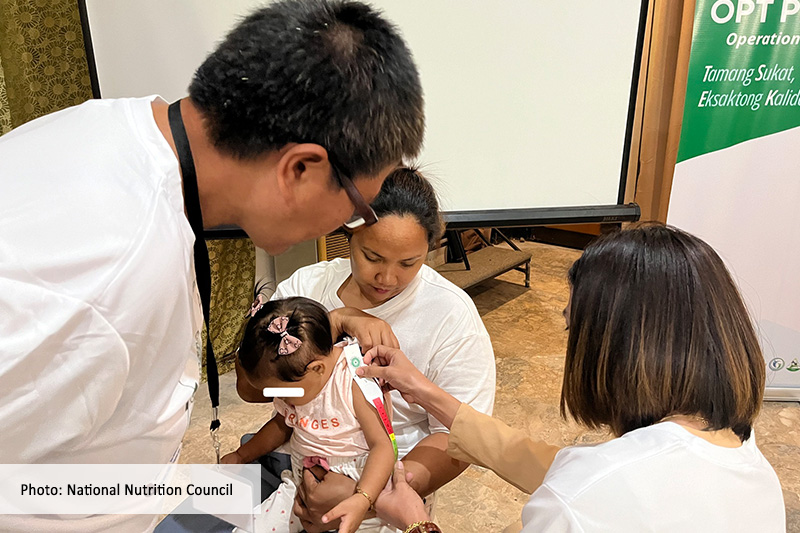
The economic and health consequences of chronic malnutrition in the country are “too enormous and extreme” and need critical and urgent attention.
This was highlighted in a recent study of state think tank Philippine Institute for Development Studies (PIDS) authored by PIDS Research Fellow Valerie Gilbert Ulep.
Citing the 2021 Joint Child Malnutrition Estimates, Ulep said “about a third or 3.5 million of Filipino children under five years old are stunted,” which is a marker of chronic malnutrition.
“Stunting is a result of chronic and recurrent stresses that the child encounters during a critical period, which starts at pregnancy until the first 1000 days of life,” he explained.
Undernutrition during pregnancy, child nutritional deficiency, and repeated infection or disease are some of the stresses that increase the risk of stunting.
Compared to countries with similar income levels, the rate of decline of stunting in the Philippines was “relatively slow” at 0 to 1 percent annually, according to Ulep. Well-performing countries, such as Viet Nam, had a 5- to 6-percent annual decline.
To help address this, Ulep emphasized the need to look at chronic malnutrition using a health system lens. The study identified issues and challenges in three health system components: health financing, health service delivery, and health governance.
On health financing, the government should “cover a comprehensive package of cost-effective health and nutrition interventions”.
However, the study revealed that nutrition-related expenditures from 2017 to 2019 were approximately PHP 1,504.06 per capita only or 0.92 percent of gross domestic product and 7.70-percent of total government expenditures. These figures show that the country’s public spending for nutrition is “low compared to other countries”.
Moreover, Ulep noted the importance of a health facility network for health service delivery. In the Philippines, primary care facilities, such as barangay health stations (BHS) and rural health units, and hospitals are not integrated. Hence, referral systems are not institutionalized.
About 10 percent of primary care facilities do not have medical doctors. There is also a limited number of community health workers.
On health governance, the roles and capacities of agencies should be clearly identified. However, agencies tasked to finance and deliver health and nutrition services in local government units (LGUs), such as the Department of Health (DOH), National Nutrition Council (NNC), and Commission on Population and Development (POPCOM), have “limited” capacity to perform these functions.
Similarly, LGUs have varying capacities to deliver health services, while the Philippine Health Insurance Corporation (PhilHealth) has limited capacity to finance comprehensive packages.
Ulep recommended long-term solutions to address chronic malnutrition in the country.
One is for the government to accelerate the implementation of the Universal Health Care Act, particularly the expansion of a well-costed outpatient benefit package.
Another recommendation is for PhilHealth to pay for a network of facilities instead of reimbursing individual hospitals or facilities to facilitate the continuous delivery of health and nutrition interventions. Using PhilHealth to pay and incentivize quality and uptake of nutrition and services could also be explored.
There is also a need to accelerate the rationalization of DOH, NNC, POPCOM, and PhilHealth functions.
Given the urgency of chronic malnutrition, the author also provided short-term solutions.
Ulep said the government should rationalize the use of its resources by classifying provinces and highly urbanized cities based on capacity and burden of chronic malnutrition.
“Given the variability of performance and capacity of LGUs, the national government must provide the type of grants depending on [their classification],” he pointed out.
In low capacity or fragile areas, the government should “explore tapping private nonprofit entities to deliver the entire package of health and nutrition interventions for a given period”. ###
This press release is based on the PIDS discussion paper “Breaking the Curse: Addressing Chronic Malnutrition in the Philippines Using a Health System Lens”.
This was highlighted in a recent study of state think tank Philippine Institute for Development Studies (PIDS) authored by PIDS Research Fellow Valerie Gilbert Ulep.
Citing the 2021 Joint Child Malnutrition Estimates, Ulep said “about a third or 3.5 million of Filipino children under five years old are stunted,” which is a marker of chronic malnutrition.
“Stunting is a result of chronic and recurrent stresses that the child encounters during a critical period, which starts at pregnancy until the first 1000 days of life,” he explained.
Undernutrition during pregnancy, child nutritional deficiency, and repeated infection or disease are some of the stresses that increase the risk of stunting.
Compared to countries with similar income levels, the rate of decline of stunting in the Philippines was “relatively slow” at 0 to 1 percent annually, according to Ulep. Well-performing countries, such as Viet Nam, had a 5- to 6-percent annual decline.
To help address this, Ulep emphasized the need to look at chronic malnutrition using a health system lens. The study identified issues and challenges in three health system components: health financing, health service delivery, and health governance.
On health financing, the government should “cover a comprehensive package of cost-effective health and nutrition interventions”.
However, the study revealed that nutrition-related expenditures from 2017 to 2019 were approximately PHP 1,504.06 per capita only or 0.92 percent of gross domestic product and 7.70-percent of total government expenditures. These figures show that the country’s public spending for nutrition is “low compared to other countries”.
Moreover, Ulep noted the importance of a health facility network for health service delivery. In the Philippines, primary care facilities, such as barangay health stations (BHS) and rural health units, and hospitals are not integrated. Hence, referral systems are not institutionalized.
About 10 percent of primary care facilities do not have medical doctors. There is also a limited number of community health workers.
On health governance, the roles and capacities of agencies should be clearly identified. However, agencies tasked to finance and deliver health and nutrition services in local government units (LGUs), such as the Department of Health (DOH), National Nutrition Council (NNC), and Commission on Population and Development (POPCOM), have “limited” capacity to perform these functions.
Similarly, LGUs have varying capacities to deliver health services, while the Philippine Health Insurance Corporation (PhilHealth) has limited capacity to finance comprehensive packages.
Ulep recommended long-term solutions to address chronic malnutrition in the country.
One is for the government to accelerate the implementation of the Universal Health Care Act, particularly the expansion of a well-costed outpatient benefit package.
Another recommendation is for PhilHealth to pay for a network of facilities instead of reimbursing individual hospitals or facilities to facilitate the continuous delivery of health and nutrition interventions. Using PhilHealth to pay and incentivize quality and uptake of nutrition and services could also be explored.
There is also a need to accelerate the rationalization of DOH, NNC, POPCOM, and PhilHealth functions.
Given the urgency of chronic malnutrition, the author also provided short-term solutions.
Ulep said the government should rationalize the use of its resources by classifying provinces and highly urbanized cities based on capacity and burden of chronic malnutrition.
“Given the variability of performance and capacity of LGUs, the national government must provide the type of grants depending on [their classification],” he pointed out.
In low capacity or fragile areas, the government should “explore tapping private nonprofit entities to deliver the entire package of health and nutrition interventions for a given period”. ###
This press release is based on the PIDS discussion paper “Breaking the Curse: Addressing Chronic Malnutrition in the Philippines Using a Health System Lens”.












